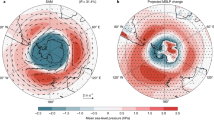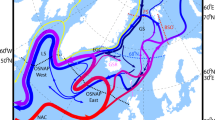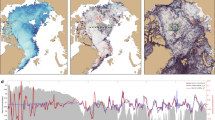Abstract
Open-ocean deep convection, one of the processes by which deep waters of the world's oceans are formed, is restricted to a small number of locations (for example, the Mediterranean and Labrador seas). Recently, the southwest Irminger Sea has been suggested as an additional location for open-ocean deep convection. The deep water formed in the Irminger Sea has the characteristic temperature and salinity of the water mass that fills the mid-depth North Atlantic Ocean, which had been believed to be formed entirely in the Labrador basin. Here we show that the most likely cause of the convection in the Irminger Sea is a low-level atmospheric jet known as the Greenland tip jet, which forms periodically in the lee of Cape Farewell, Greenland, and is associated with elevated heat flux and strong wind stress curl. Using a history of tip-jet events derived from meteorological land station data and a regional oceanic numerical model, we demonstrate that deep convection can occur in this region when the North Atlantic Oscillation Index is high, which is consistent with observations. This mechanism of convection in the Irminger Sea differs significantly from those known to operate in the Labrador and Mediterranean seas.
This is a preview of subscription content, access via your institution
Access options
Subscribe to this journal
Receive 51 print issues and online access
$199.00 per year
only $3.90 per issue
Buy this article
- Purchase on Springer Link
- Instant access to full article PDF
Prices may be subject to local taxes which are calculated during checkout





Similar content being viewed by others
References
Nansen, F. Das Bodenwasser und die Abkühlung des Meeres. Int. Rev. Ges. Hydrobiol. Hydrogr. V, 1–42 (1912)
Wüst, G. Der subarktische Bodenstrom in der westatlantischen Mulde. Ann. Hydrogr. Marit. Meteorol. IV/VI, 249–256 (1943)
Nielsen, J. Greenland. The Discovery of Greenland, Exploration, and the Nature of the Country Vol. I, 185–230 (C.A. Reitzel, Copenhagen, 1928)
Pickart, R. S., Straneo, F. & Moore, G. W. K. Is Labrador Sea Water formed in the Irminger Basin? Deep Sea Res. I 50, 23–52 (2003)
Sy, A. et al. Surprisingly rapid spreading of newly formed intermediate waters across the North Atlantic Ocean. Nature 386, 675–679 (1997)
Rhein, M. et al. Labrador Sea water: Pathways, CFC-inventory, and formation rates. J. Phys. Oceanogr 32, 648–665 (2002)
Bumpke, K., Karger, U. & Uhlig, K. Measurements of turbulent fluxes of momentum and sensible heat over the Labrador Sea. J. Phys. Oceanogr. 32, 401–410 (2002)
Moore, G. W. K. & Renfrew, I. A. An assessment of the surface turbulent heat fluxes from the NCEP-NCAR reanalysis over the western boundary currents. J. Clim. 15, 2020–2037 (2002)
Pickart, R. S., Torres, D. J. & Clarke, R. A. Hydrography of the Labrador Sea during active convection. J. Phys. Oceanogr. 32, 428–457 (2002)
Doyle, J. D. & Shapiro, M. A. Flow response to large-scale topography: the Greenland tip jet. Tellus 51, 728–748 (1999)
Cappelen, J., Jorgensen, B. V., Laursen, E. V., Stannius, L. S. & Thomsen, R. S. The Observed Climate of Greenland, 1958–99, with Climatological Standard Normals, 1961–90 (Technical Report 00-18, Danish Meteorological Institute, Copenhagen, 2001)
Labsea Group. The Labrador Sea deep convection experiment. Bull. Am. Meteorol. Soc 79, 2033–2058 (1998)
Browning, K. A., Chalon, J.-P. & Thorpe, A. J. The Fronts and Atlantic Storm-Track Experiment (FASTEX). Q. J. R. Meteorol. Soc. 125, 3129–3617 (1999)
Renfrew, I. A., Moore, G. W. K., Holt, T. R., Chang, S. W. & Guest, P. Mesoscale forecasting during a field program: Meteorological support of the Labrador Sea deep convection experiment. Bull. Am. Meteorol. Soc. 80, 605–620 (1999)
Renfrew, I. A., Moore, G. W. K., Guest, P. S. & Bumpke, K. A comparison of surface-layer heat flux and surface momentum flux observations over the Labrador Sea with ECMWF analyses and NCEP reanalyses. J. Phys. Oceanogr. 32, 383–400 (2002)
Naderi, F. M., Freilich, M. H. & Long, D. G. Spaceborne radar measurement of wind velocity over the ocean—An overview of the NSCAT scatterometer system. IEEE Proc. 79, 850–866 (1991)
Hurrell, J. W. Decadal trends in the North Atlantic Oscillation regional temperatures and precipitation. Science 269, 676–679 (1995)
Rogers, J. C. Patterns of low-frequency monthly sea level pressure variability (1899–1986) and associated wave cyclone frequencies. J. Clim. 3, 1364–1379 (1990)
Dickson, R. R., Lazier, J. R. N., Meincke, J., Rhines, P. B. & Swift, J. Long-term coordinated changes in the convective activity of the North Atlantic. Prog. Oceanogr. 38, 241–295 (1996)
Dickson, R. R. & Meincke, J. in Trans. ICES Symp. Hydrobiological Variability in the ICES Area, 1990–99 (ed. Turrell, William) (ICES Marine Science Symposium Series, Copenhagen, 2003)
Marshall, J., Hill, C., Perelman, L. & Adcroft, A. Hydrostatic, quasi-hydrostatic, and non-hydrostatic ocean modeling. J. Geophys. Res. 102, 5733–5752 (1997)
Schott, F. et al. Observations of deep convection in the Gulf of Lions, Northern Mediterranean, during the winter of 1991/92. J. Phys. Oceanogr. 26, 505–524 (1996)
Madec, G., Lott, F., Delecluse, P. & Crepon, M. Large-scale preconditioning of deep-water formation in the Northwestern Mediterranean Sea. J. Phys. Oceanogr. 26, 1393–1408 (1996)
Milliff, R. F. & Morzel, J. The global distribution of the time-averaged wind stress curl from NSCAT. J. Atmos. Sci. 58, 109–131 (2001)
Acknowledgements
We thank L. Rasmussen for discussions about the meteorology around Greenland. The NSCAT surface winds were derived from the KU2000 retrieval provided by Remote Sensing Systems Inc. Support for this work was provided by the Ocean Sciences Division of the National Science Foundation.
Author information
Authors and Affiliations
Corresponding author
Ethics declarations
Competing interests
The authors declare that they have no competing financial interests.
Rights and permissions
About this article
Cite this article
Pickart, R., Spall, M., Ribergaard, M. et al. Deep convection in the Irminger Sea forced by the Greenland tip jet. Nature 424, 152–156 (2003). https://doi.org/10.1038/nature01729
Received:
Accepted:
Issue Date:
DOI: https://doi.org/10.1038/nature01729
This article is cited by
-
Century-long cooling trend in subpolar North Atlantic forced by atmosphere: an alternative explanation
Climate Dynamics (2022)
-
Evidence for influx of Atlantic water masses to the Labrador Sea during the Last Glacial Maximum
Scientific Reports (2021)
-
Glacial–interglacial Nd isotope variability of North Atlantic Deep Water modulated by North American ice sheet
Nature Communications (2019)
-
Plausible Effect of Weather on Atlantic Meridional Overturning Circulation with a Coupled General Circulation Model
Journal of Ocean University of China (2018)
-
Emergence of deep convection in the Arctic Ocean under a warming climate
Climate Dynamics (2018)
Comments
By submitting a comment you agree to abide by our Terms and Community Guidelines. If you find something abusive or that does not comply with our terms or guidelines please flag it as inappropriate.



